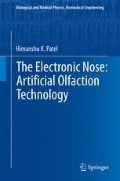Abstract
Electronic nose sensors produce signals when they are in contact with the analytes or VOC or gas. These signals can be noisy, of low amplitude, biased, and dependent on secondary parameters such as temperature. Hence it is required to put them into a measurable format for which signal conditioning is required. It is performed using electronic circuitry which may be A/D conversion, filtering, amplification, etc., and it is discussed here. An electronic nose sensor data analysis is non-conventional type data analysis. In this chapter, most frequently used data analysis techniques for electronic nose are discussed.
Access this chapter
Tax calculation will be finalised at checkout
Purchases are for personal use only
References
“Instrumentation engineering handbook”, National nuclear security administration (NEVADA), Dec (2005)
H.W. Shin, A hybrid electronic nose system for monitoring the quality of potable water. Ph.D. Thesis, University of Warwick, School of Engineering, Oct (1999)
Ricardo Gutierrez-Osunae et al., A method for evaluating data-preprocessing techniques for odour classification with an array of gas sensors. IEEE Trans. Syst. Man Cybern. Part B: Cybern. 29(5), 626–632 (1999)
P.C. Jurs, G.A. Bakken, H.E. McClelland, Computational methods for the analysis of chemical sensor array data from volatile analytes. Chem. Rev. 100, 2649–2678 (2000)
M. Otto, in Chemo-metrics: statistics and computer application in analytical chemistry, (Wiley-VCH, NY, 1999), pp , pp. 119–174
S.M. Scott, D. James, Z. Ali, Data analysis for electronic nose systems. Microchim. Acta 156, 183–207 (2007)
E. Llobet, E.L. Hines, J.W. Gardner, P.N. Bartlett, T.T. Mottram, Fuzzy ARTMAP based electronic nose data analysis. Sensors and Actuators B 61, 183–190 (1999)
M.J. Adams, Chemometrics in analytical spectroscopy (Royal Society of Chemistry, Cambridge, 1995), pp. 70–79
J.W. Gardner, P.N. Barlett, Electronic noses: principles and applications, (Oxford University Press, Oxford, 1999)
L.I. Smith, A tutorial on principal components analysis, http://www.cs.otago.ac.nz/cosc453/student_tutorials/principal_components.pdf (2002)
J. Roden, D. Trout, B. King, A Tutorial on PCA Interpretation using Comp. Clust http://woldlab.caltech.edu/compclust/pca_interpretation_tutorial.pdf (2005)
T. Kohonen, Self organized formulation of topologically correct feature maps. Biol. Cybermatics 43, 59–69 (1982)
C. Distante, P. Siciliano, K.C. Persuad, Dynamic cluster recognition with multiple self-organizing maps. Pattern Anal. Appl. 5, 306–315 (2002)
M. Zuppa et al., Drift counteraction with multiple self-organizing maps for an electronic nose. Sens. Actuators B 98, 305–317 (2004)
E. Mooi, M. Sarstedt, A concise guide to market research: the process, data and methods using IBM SPSS Statistics. (Springer, Berlin, 2011), ISBN:- 978-3-642-12540-9.(Chapter 9)
Author information
Authors and Affiliations
Corresponding author
Rights and permissions
Copyright information
© 2014 Springer India
About this chapter
Cite this chapter
Patel, H.K. (2014). Sensor Circuits. In: The Electronic Nose: Artificial Olfaction Technology. Biological and Medical Physics, Biomedical Engineering. Springer, New Delhi. https://doi.org/10.1007/978-81-322-1548-6_7
Download citation
DOI: https://doi.org/10.1007/978-81-322-1548-6_7
Published:
Publisher Name: Springer, New Delhi
Print ISBN: 978-81-322-1547-9
Online ISBN: 978-81-322-1548-6
eBook Packages: EngineeringEngineering (R0)

